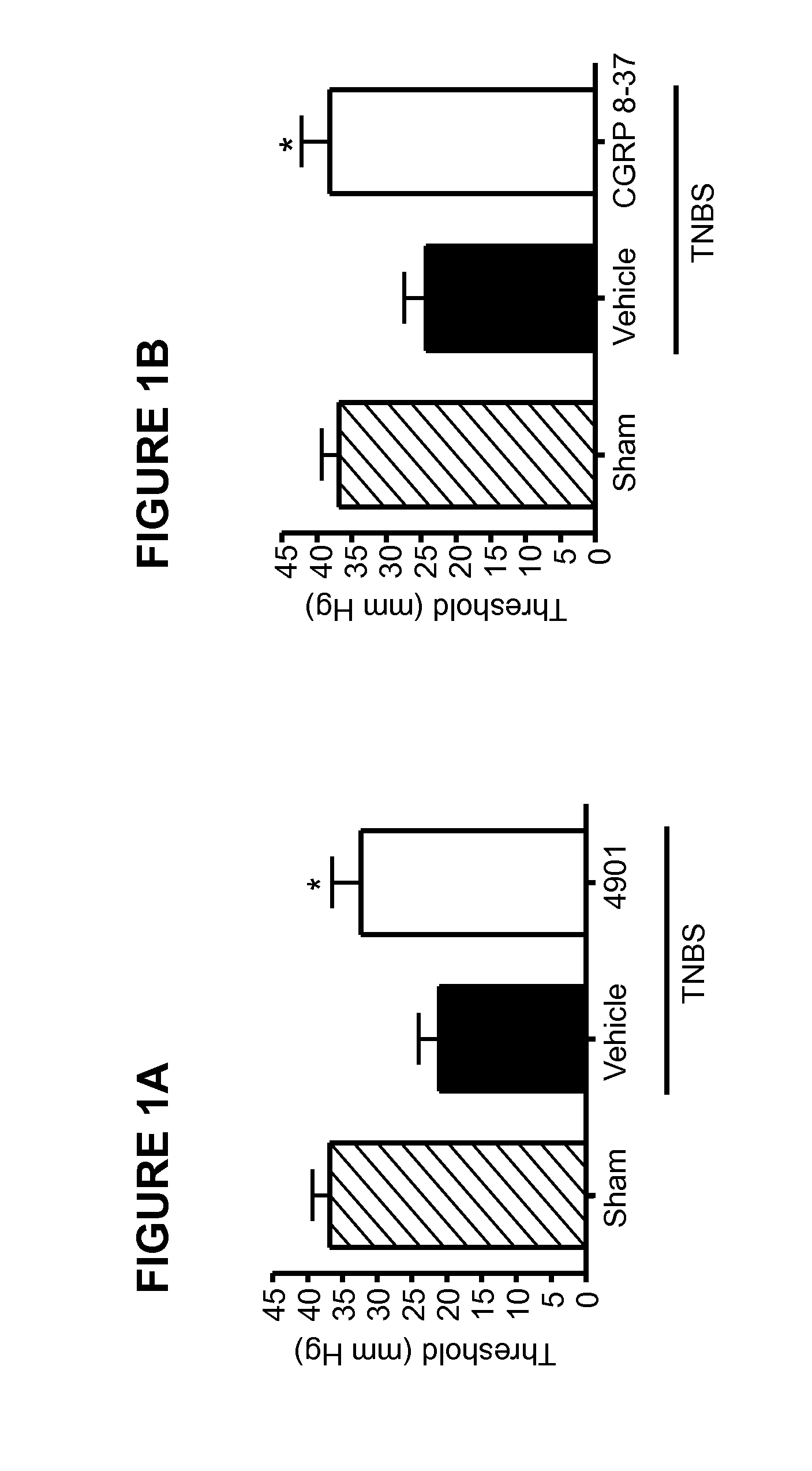Methods for treating visceral pain by administering antagonist antibodies directed against calcitonin gene-related peptide
a technology of calcitonin gene and antagonist antibody, which is applied in the direction of antibody medical ingredients, immunoglobulins against hormones, drug compositions, etc., can solve the problems of limited effectiveness of visceral pain treatment, difficult clinical management of visceral pain, and diminished efficacy, so as to prevent visceral pain
- Summary
- Abstract
- Description
- Claims
- Application Information
AI Technical Summary
Benefits of technology
Problems solved by technology
Method used
Image
Examples
example 1
Visceral Pain Model
[0170]This Example illustrates the effect of anti-CGRP antagonist antibody treatment in a visceral pain model.
[0171]Patients with IBS have been shown to have a lower visceral sensory threshold to colorectal distension and that this is highly correlated to the visceral pain symptoms (Delafoy et al, 2006). Colorectal distension after TNBS-induced colitis in rats is an animal model that has been used by many researchers to explore the mechanisms of visceral hypersensitivity (Gay et al, 2006, Delafoy et al, 2006, Adam et al., 2006). In this Example, the rat TNBS colitis model was used to test the effect of a function-blocking antibody for CGRP. In the model, as in the human IBS studies, the visceral pain threshold is measured by response to balloon distension of the colon.
[0172]After overnight fasting, rats were anesthetized with ketamine (80 mg / ml) / xylazine (12 mg / ml) at a dosage of 1 ml / kg. An abdominal laparotomy was performed and a TNBS solution (50 mg at 1.5 ml / k...
example 2
Interaction Analysis and Binding Assay
[0175]Interaction analysis was conducted at 25° C. and at 37° C. on a Biacore 3000™ system equipped with streptavidin-coated (SA) sensor chips (Biacore AB, Uppsala, Sweden) using standard Biacore running buffers (HBS-P or HBS-EP). N-LC-biotinylated human and rat α- and β-CGRPs were captured on individual flow cells at low levels (typically 100 response units) to provide the reaction surfaces, while an unmodified flow cell served as a reference channel. Purified Fab fragments of antibodies G1 and G2 were generated. Typically, Fabs were prepared as a two-fold serial dilution using 0.5 μM as the top concentration and injected for 1-min at 100 μl / min allowing up to two hours for the dissociation time. Surfaces were regenerated with a mixture of 50% v / v ethanol+25 mM NaOH for G1 Fab and 2:1 v / v Pierce Gentle Elution Buffer / 4M NaCl for G2 Fab. Fab injections were duplicated to demonstrate that the assay was reproducible. The binding responses were dou...
example 3
Visceral Pain Model
[0182]This Example illustrates the effect of anti-CGRP antagonist antibody treatment in a visceral pain model.
[0183]In this Example, the rat interstitial cystitis model was used to test the effect of a function-blocking antibody for CGRP. In the model, visceral hypersensitivity was measured by bladder motility in response to turpentine irritation of the bladder.
[0184]Female rats were maintained under urethane anesthesia during cystometry and were not allowed to recover. Body temperature was maintained at 37° C. by the use of a rectal probe, thermostatically connected to a temperature controlled heating pad. One group of rats (n=7) received anti-CGRP antagonist monoclonal antibody 4901 (commercially available at Sigma (Missouri, US), product number C7113, clone #4901) at 10 mg / kg intravenously. Another group (n=7) received vehicle (PBS, 0.01% tween 20) as a negative control.
[0185]Twenty-four hours after dosing with 4901 or vehicle, rats were anesthetized, and the b...
PUM
| Property | Measurement | Unit |
|---|---|---|
| half life | aaaaa | aaaaa |
| concentration | aaaaa | aaaaa |
| concentration | aaaaa | aaaaa |
Abstract
Description
Claims
Application Information
 Login to View More
Login to View More - R&D
- Intellectual Property
- Life Sciences
- Materials
- Tech Scout
- Unparalleled Data Quality
- Higher Quality Content
- 60% Fewer Hallucinations
Browse by: Latest US Patents, China's latest patents, Technical Efficacy Thesaurus, Application Domain, Technology Topic, Popular Technical Reports.
© 2025 PatSnap. All rights reserved.Legal|Privacy policy|Modern Slavery Act Transparency Statement|Sitemap|About US| Contact US: help@patsnap.com



